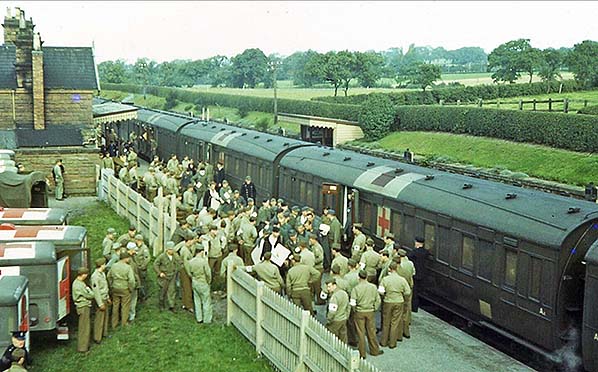
Station Name: MALPAS
|
| Date opened: | 1.10.1872 |
| Location: | North side of Chester Road (B5069) |
| Company on opening: | London & North Western Railway |
| Date closed to passengers: | 16.9.1957 |
| Date closed completely: | 4.11.1963 |
| Company on closing: | British Railways (London Midland Region) |
| Present state: | Station building still extant in use as office accommodation. Part of the platform in front of the building and the iron supports for the canopy also survive. |
| County: | Cheshire |
| OS Grid Ref: | SJ497493 |
| Date of visit: | 28.5.2006 |
Notes: Malpas Station was located on the LNWR’s line that ran from a junction on the Crewe to Chester line, approximately two miles to the north of Tattenhall Village, to the market town of Whitchurch. The line was opened by the LNWR on 1st October 1872 and it was 14 miles in length and built to main line standards with double track throughout. It was intended to provide competition to the GWR route between Chester and Shrewsbury and the LNWR hoped that it would attract the majority of the coal traffic from South Wales which was destined for the Mersey Docks in Birkenhead. Some coal traffic did use the line, especially that originating from the Abergavenny - Merthyr line which was also under LNWR control .However most of the coal traffic bound for Birkenhead came from the North Wales coal fields around Wrexham which was GWR or GCR territory, this did not use the Whitchurch - Waverton line
Coal traffic from South Wales formed the bulk of early freight workings, probably passing over the branch at night en route for Birkenhead. Apart from competition from the GWR route from the Wrexham coalfield, there was also stiff competition from coastal shipping from the 1890’s and this traffic declined after the First World War.
During WW1 On the eve of an official visit to Chester in May 1917, the Royal Train carrying George V and Queen Mary stopped for the night at Malpas station. Troops from the Household Division guarded the area throughout the stay.
The area through which the line passed is quite rural and because of this passenger numbers were never very large and never reached expectations although it did help Tattenhall's popularity as a commuter centre for nearby Chester. The branch declined rapidly after WW2 with more and more commuters abandoning railways in favour of more convenient road transport while an ever increasing amount of goods traffic switched over from cars to lorries.
Today the station building at Malpas still stands. It is in use as office accommodation for Miles Mcadam Ltd. and many of the stations railway features have been preserved. Additional source: London & North Western Railway Society Journal September 2004 and Backtrack magazine March 2007, thanks to Tony Robinson for sending his text from these journals. Further reading: Down the Line by RM Bevan - A nostalgic journey along the old branch railway from Waverton (Chester) to Whitchurch, CC Publishing. Tickets from Michael Stewart To see other stations on the Waverton - Whitchurch line click on the station name: Whitchurch, Grindley Brook Halt, Broxton, Tattenhall & Waverton |
old1.jpg)
Copyright photo from John Mann & RM Casserley collections


4.jpg)
Photo by Alan Young
1.jpg)
Photo by Paul Wright





 Home Page
Home Page